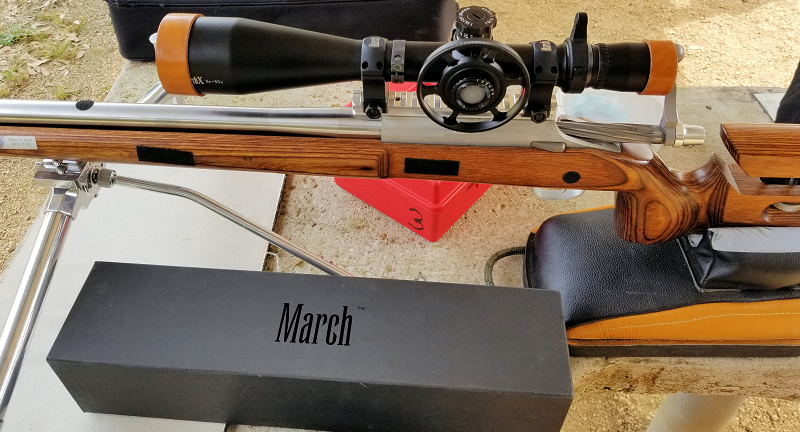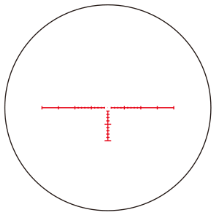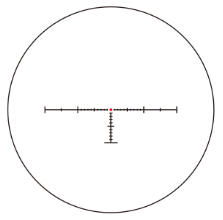News Category
Archive
Newly Posted
My reasons for selecting a March Scope – Denys Beauchemin
Posted 11/13/2019
March Scope Owner, Denys Beauchemin has kindly shared a report with us.
I think you will find his report intriguing as he states objective reasons for selecting a March Scope (March-X 5-50x56mm)
replacing another one. Have fun reading !

The following article was written January 2015. Please see the update at the end.
Introduction.
In this review, I will discuss my reasons for selecting a March scope 5-50x56mm to replace my existing Nightforce NXS
on my F-TR rig and then go through a review and findings followed by my conclusions.
Background.
This shooter is 60 years old and has been wearing glasses in excess of 47 years and bifocals for almost 20 years.
I am a software engineer by training and trade (40 years) who spends most of his days looking at computer screens.
I started programming using cards and an IBM 026 keypunch machine in the mid-70s
and moved on to an HP2645 CRT in 1977, green screen 24X80.
My current setup at my home/office involves a 4K display connected to my high-end laptop.
I have been an avid photographer all my life and currently use a Nikon 5200 for which I have multiple lenses.
I have been around optics and lenses forever and I know about f-ratio, filters, resolution, apertures, depth of field, etc.
and the various trade-offs inherent in optical lenses.
I have been using a Nightforce NXS for a couple of years and while I think it is a great scope,
my aging (and optics-savvy) eyes have been desiring something better for the early morning winter matches
and the heavily overcast days as well as better definition of the rings at maximum magnification.
Existing setup.
About 3 years ago, I bought a Nightforce NXS 12-42X56 with the NP2DD reticle and 1/8 MOA dials
and installed on it my then F-TR rifle while waiting for my current F-TR rifle parts.
The NXS has a 30mm tube and a range of about 45MOA for elevation.
This indicated to me that the internal lenses are bigger than the ones used in a 1 inch riflescope;
in other words Nightforce, to their credit, had taken optical advantage of the 30mm tube instead of
the marketing advantage by eschewing the 80MOA range they would get using smaller internal lenses.
The 56mm objective lens does a great job of letting in a lot of light and the bigger internal lenses have a correspondingly
bigger sweet spot and thus better resolution and a higher f-ratio which makes the image appear brighter or clearer.
However, I was somewhat disappointed by the fact the image appeared dark
and grainy when I was using 42X magnification in times other than midday bright sunshine.
However, most of the time I shoot at high magnification, it is not really dark outside after spring has sprung and then turned into summer.
If there is one thing we have a lot of in Houston during summertime, it is sunshine.
I just turn down the magnification when it’s darker outside and everything is brighter but smaller. Trade-offs.
Defining the problems.
In Highpower competition, our targets are black on tan and the reticles in the scopes are invariably black.
Sometimes it is difficult for me to see the fine black dot of the NP2DD reticle on the aiming black of the target,
especially in the early morning matches.
I have taken to turning on the illumination for the reticle, but on the NXS the adjustment of this illumination
is primitive at best and so it was not a complete solution.
The rings were a little fuzzy at 42X even after adjusting the side focus as best I could.
My impression was that I was experiencing the limits of the glass and running into chromatic aberration
whereby the glass was not able to focus the tan rings and the aiming black background onto the same convergence points.
To my eyes, it looked like color fringing; the rings were just not as sharp as I had hoped they would be.
Of course, atmospheric disturbances (mirage) just made things worse but that would come later in the day.
Thinking about solutions.
ED glass, or Extra-low Dispersion glass, is designed to reduce or eliminate chromatic aberration in lenses
by reducing the dispersion of the various wavelengths, or focusing them better as a group at the same place,
if I can use some layman terms to explain. In theory, repeat, in theory, using ED glass “should” produce a sharper image
of the target rings to my eyes at high magnification and “may” even reduce the fuzziness of the rings in mirage conditions.
For a while now, I have speculated that uber-expensive spotting scopes actually minimized the effects of mirage
due to the ED glass they use and that perhaps that was not “good thing” when trying to read the conditions.
On the other hand, this would be “a good thing” for riflescopes on F-class rifles
when you can use a separate spotting scope to read these conditions.
So, if I were to replace my NXS for something better, it would have to have high quality ED glass.
But what about the other issue, the reduced brightness of the image at dawn and on overcast days?
The amount of light that enters an optical riflescope is dictated by the size of the objective, period.
A riflescope does not “gather” light or “suck in” light, it is passive and light gets into it according to the size of the objective lens.
We talk about the size of the exit pupil as a factor of objective lens diameter divided by the magnification.
If I wanted to stay at 42X or thereabouts, I wanted to have at least a 56mm objective; not a smaller one.
Bigger than 56mm would be nice, but those are rare and it starts to get very big on the rifle.
Once the light enters the optical riflescope, it will only get reduced, never amplified.
The main thing that reduces the amount of light is the air/glass boundary.
When light goes from one medium to another, various wavelengths are affected differently and some bounce off the boundary more than others.
In uncoated lenses, each air/glass boundary takes away about 5% of the light that is going through the riflescope.
When you have a fixed power scope, that is not too bad as there are only a few lenses but 5% at every boundary still adds up.
In a variable scope, the addition of the zoom lenses increased the number of boundaries and the amount of light lost.
Enter coating, the technology that uses an ultra-thin film of material on the surface of the lens that counters,
or at least reduces the effect that robs a portion of the light at the air/glass boundary.
Various coatings work for different wavelengths and a top quality glass will be “multi-coated” rather than
just “coated” to handle all the wavelengths, thus producing a higher color fidelity image to the eye.
You also want to have the coating on both sides of the lenses so you look for the word “fully” in the description.
So “fully multi-coated” is where it’s at.
There are other coatings available to do other things such as scratch resistance and moisture repellence and so on.
And of course, companies tout their coating methods over others.
So when we talk about light “transmission” through the riflescope, fully multi-coated lenses can produce
a light transmittance factor of 92% or 95% or thereabouts instead of the 70% left over going through uncoated glass.
95% is about the best that can be attained now and there are differences in this between day time and night time.
I had read somewhere that the NXS had an 88% light transmission factor in daylight. Not very good, but not too bad.
As for magnification, I thought the 42X of the NXS was fine, I never really desired for much more
as it just reduces my field of view and could cause crossfires.
Also, when it was bright outside, the mirage would be out in force and higher magnification would not help.
So in order of importance; top end magnification of at least 40-50X range but no need for much more,
56mm minimum for objective lens, ED glass and 30mm tube with proper adjustment range.
Of course it would have to be no heavier than the piggish NXS at 32 ounces.
Essentially, there were very few scopes that met one or more of these parameters.
I briefly considered the NF Competition, but with a 52mm objective AND a 30mm tube,
it would not provide the additional benefits that I needed to have to justify a change.
The new Leupold VX-6 7-42X56 seemed to fit the stipulated requirements, as does the Schmidt and Bender 12X50-56 PM II/P.
The latter was eliminated because of its weight of 1.110 kilo, even more than the current NXS.
Back in the fall of 2014, I invited Jim Kelbly and his road show to the Bayou Rifles range and he showed up on a Sunday
when we were holding a 600yard match and allowed shooters to look through a plethora of March scopes, at their own range.
A few month later I started a conversation with Jim about a scope and we discussed some of my requirements
and he pointed me to the March-X with the 34mm tube.
The additional 4mm in the tube is due to fact the tube wall thickness is 4mm instead of the regular 2mm.
This makes for a very strong scope.
So the decision was between the Leupold VX-6 and the March-X.
In the end, I opted for the 20% or so increase in top end magnification and to me,
the illuminated MTR-2 reticle of the March-X was preferable
as compared to the TMOA reticle of the Leupold VX-6.
Also if the Leupold uses ED glass, they are keeping it a secret.
Installing the March-X 5-50x56mm.
I received the March-X 5-50x56mm at the end of last year along with a set of Kelbly’s excellent 34mm rings and installed the scope on my rifle last week.
Before you ask, I did not lap the rings. I set the rings on a flat surface and placed the scope in the rings turning the screws very loosely
in a position that would place the eyepiece very close to the existing one.
I set the magnification at 40X, to match what I would see with the NXS at its maximum magnification.
Then I set up my F-TR rifle without its bolt on its Sinclair 3rd gen bipod and placed it in the Seb rear bag and pounded it in.
I locked everything level on the bipod and made sure nothing moved.
I focused and aimed the scope at very specific spot on an object across the way.
Next I loosened the screws holding the rings to the dovetail mount and slowly slipped the NXS out still in its rings,
making sure not to disturb anything.
I slipped the March-X 5-50x56mm scope in its new 34mm rings on the dovetail, making sure nothing moved.
I tightened the screws holding the rings to the dovetail but only finger tight and looked through the scope.
The vertical line was nearly the same but the elevation was off, as I expected.
I dialed the elevation until the reticle was very near or at the same spot as before on the object.
Then I carefully removed the scope and replaced the NXS and confirmed that the rifle had not moved at all.
I swapped the scopes again and this time tightened the main screws to the torque specified in the manual.
I adjusted the scope so the dot would be right at the same spot as before, confirmed the reticle was level with my levels
and tightened the ring screws to 12 in-lbs as per the instructions.
I figured I would be close enough at 1000 yards that I should be able to be on paper rapidly and go from there.
First match with the March-X 5-50x56mm.
This past weekend, I shot a match with the scope for the first time.
During setup I noticed that looking through the scope at 40X, it was much brighter than what I remembered with the NXS
and it was early in the morning a week after the longest night of the year, winter solstice.
And it was heavily overcast to boot. These where the exact conditions that had prompted me to look for something better than my NXS.
With the March-X 5-50x56mm, I had no problems seeing the target and the image
was clear and bright, almost like it was midday on a bright summer day.
The rings were razor sharp and the reticle stood out nicely from the black target.
I played with the illumination and it was exactly what I needed at its lowest setting (it has 4 settings, by just pressing a button.)
I knew then that I had accomplished what I had set out to do.
Now I had to worry about getting on target and getting a zero, at least for elevation.
The first shot was low and right, I actually saw the splash in the protective berm and I was in the black, in the 9 ring by the third shot.
The wind was howling from the front left and that’s what had help pushed me off the target
and the 35 degrees temperature with that frontal wind made the bullets slower than usual.
Also the method of mounting the scope was really a kludge but it was the best I could do in the timeframe I had.
All in all, it turned out fine.
Since there was no mirage, I increased the magnification to its maximum of 50X and was surprised at
how bright and crisp the 24% bigger target looked.
I had no problem setting finding a proper cheekweld.
The scope was essentially in the same position as its predecessor and the eye relief was similar enough.
I might refine it a bit in time, or I may just use it as is.
One of the complaints I’ve had with the NXS was fighting with the magnification ring.
No such complaint with the March; the magnification ring works just fine
and has the proper amount of resistance so that I can change it from position.
The side-focus was the same way and it was easy to adjust, but not so easy that it would change just touching it.
I played with the elevation and windage knobs and while I liked the feel of these knobs on the NXS,
I also like the feel of the ones on the March-X 5-50x56mm even though it’s a different feel.
Both are positive clicks and easy to count or just get a single click.
I spent more time looking through the scope than actually shooting, the image was so good.
I just could not get over it how good it was.
I could hardly believe the difference in clarity and brightness.
In retrospect, I had done my homework and the scope I selected lived up to its specs.
The reticle is reminiscent of the NP2DD but it is a little different in that it has hash marks.
I found myself using these marks to center the hold when I was holding dead-center.
These should come in handy when holding off paper on in the “white”. I will find out over time.
It will be a few more months before mirage really comes into play,
and I look forward to seeing how the ED glass performs and if it actually makes a difference.
Any improvement there would be a bonus at this point.
Conclusion.
A need for something better than what I had was recognized and the parameters
for meeting these needs were identified and defined to exact specifications.
The search was not very long because these specs were so very precise and “extreme.”
The first outing occurred in conditions that were the ones pushing me to look for something better.
The results proved that the analysis and resolution were spot on. It’s nice when a plan comes together.
Would the Leupold VX-6 do as well? Most probably but I do enjoy the extra 20% magnification while the air is clear.
And I definitely like the illuminated MTR-2 reticle even though I won’t be using the illumination much.
The NXS is an awesome scope and it has served me well for these three years.
I’m hoping the March-X 5-50x56mm will be as faithful and be as dependable; only time will tell.
UPDATE (November 2019):
I wrote the preceding article in winter January 2015.
Since that time, my March-X 5-50x56mm scope has performed excellently.
A few months back I sent it to Japan to replace the MTR-2 reticle with their new MTR-5 reticle
because my aging eyes had problems discerning the thin MTR-2 reticle on the target.
It was fine 5 years ago, it became a problem about a year ago, and now the MTR-5 is performing very well for me.
It’s got the same subtensions as the MTR-2 but it’s twice as thick.
Also, I have standardized on running my scope at 40X all the time, which makes the MTR-2 or MTR-5 reticle
show excellent dimension on the target.
I added the large side focus wheel that allows me to fine tune the focus easily.
I changed the rail on the rifle to a Picatinny model and replaced the Kelby dovetail rings with March Picatinny rings.
My setup has seen over 20,000 F-TR rounds through it since I mounted the March scope and it’s been perfect.
Very solid.


